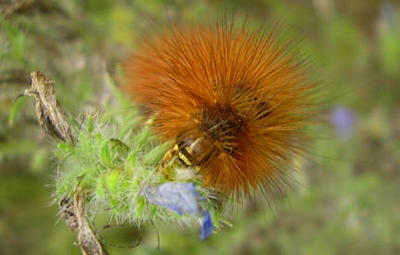I took this picture of a caterpillar back in August, I had no idea what it is.

Over at What's that Bug, they seem to identify every fuzzy caterpillar as a wooly bear, as a caterpillar of a tiger moth. I've always reserved the name "wooly bear" for the black/brown and orange caterpillars, the common banded wooly bear, adult Isabella tiger moth (family, Arctiidae), that appear all over the place in the fall. Word is, you can predict the severity of the winter to come by the width of the lighter band--if you know which way it goes, i.e., whether a wider orange band means milder or more severe. Sadly, I don't know this.

I searched around with my tiger moth clue, to no avail, until I remembered to check Bev Wigney's gallery, where I found an image of the caterpillar of a Virginian tiger moth. (The great thing about Bev is not only that her photographs are so good, but she takes most of them not too far east of Thomasburg.) I don't see any yellow on her caterpillar, but otherwise it seems very similar to mine--could it be?






3 comments:
That camera of yours was certainly a great investment! Wonderful pictures. I think you've chosen even a more difficult identification than the moth that stumped me. I wish I knew something about these critters but it's all beyond my limited knowledge.
Thanks for your help!
The way the old myth goes (the one that says you can tell the severity of the coming winter by the bands on the wooly bear caterpillar's back)is this: thicker orange bands mean a milder winter; thicker dark bands mean a harsher winter.
I also recently found a caterpillar like this on Vipers Bugloss and have not been able to find an ID. I saw your pic in a google search which has been the only direct match i've been able to locate. Any further resolution of this one?
Post a Comment